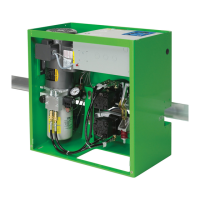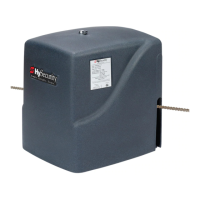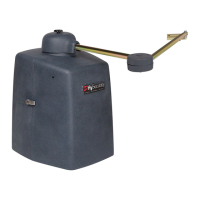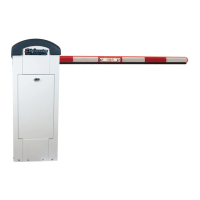96 MX3630-01 Rev. J SlideDriver/SlideDriver 50VF Series © 2019 www.hysecurity.com
Photo Eyes (Non-Contact) Installation
Plan to integrate photo eyes (photoelectric sensors) in your site plan. Photo eyes are wired to the Controller
and require low voltage conduit to the operator and power supply. Refer to IMPORTANT SAFETY
INFORMATION on page 13.
If there are no other external entrapment protection sensors (typically an edge sensor), then for slide gates,
swing gates or any site that must comply with UL 325 monitored entrapment protection regulations, it is highly
recommended that at least two photo eyes are installed to serve and reverse the gate in each direction of
travel (Open and Close directions).
Underwriters Laboratories requires that any noncontact sensor used as an external entrapment protection
device, must be tested to, and recognized by, the UL 325 Standard.
• There are two common types of photoelectric sensors, thru-beam and retro-reective, and each has its
advantages.
• A thru-beam sensor is generally more powerful and able to function reliably with dirty optics and in
poor weather.
• A retro-reective sensor does not require the installation and extra wiring of a separate emitter
and receiver as is required in a thrubeam system, but retro-reective eyes are generally more
problematic in poor weather. Avoid using retro-reective devices across outdoor distances greater
than 24 ft (7.3m) because of performance and reliability issues.
• For pedestrian detection, mount thru-beam type photo eyes approximately 15” to 30” (38 to 76cm)
above the ground and as close to the gate as possible. A minimum of one photo eyes is required,
but two is recommended, one photo eye to guard the open direction and the other for the close
direction of travel, unless gate edges for entrapment protection are installed.
• Three wires to the receiver and two wires to the emitter are all that is required.
• Depending on how the photo eyes are to be wired, +24VDC or +12VDC, power is provided via
spades located just to the right of the COM terminal strip near the left side of the board.
• The receiver and emitter common wires are connected to the SENSOR COM terminal at the bottom,
left of the Smart Touch Controller.
• The photo eye NO or NC output wires connect to the Smart DC Controller at the Appropriate
Sensor Input (1, 2, or 3). The appropriate sensor input must be programmed for Eye Open or Eye
Close based on whether it spans the road or the “catch” area of an opening gate.
• If tripped while in motion, the standard function is to stop the gate and automatically restart again if
the photo eye is clear within ve seconds. An optional setting in the Installer Menu will cause a two
second reversal of travel, or, if closing, can be programmed to reverse to full open.
NOTICE: Sensor COM & +24V is the recommended way to connect monitored photo eyes to Smart DC
Controller.
NOTICE: If photo eyes are to be used for vehicle detection and logically function the same as a vehicle detector,
connect the common wires to the COM terminals on the left side of the board and wire the NO output contact to
the appropriate vehicle detector input: EXIT LOOP, IN OBS LOOP, and OUT OBS LOOP.
Compatibility
The UL 325 Standard of Safety requires that a photoelectric sensor be laboratory tested and “recognized”
